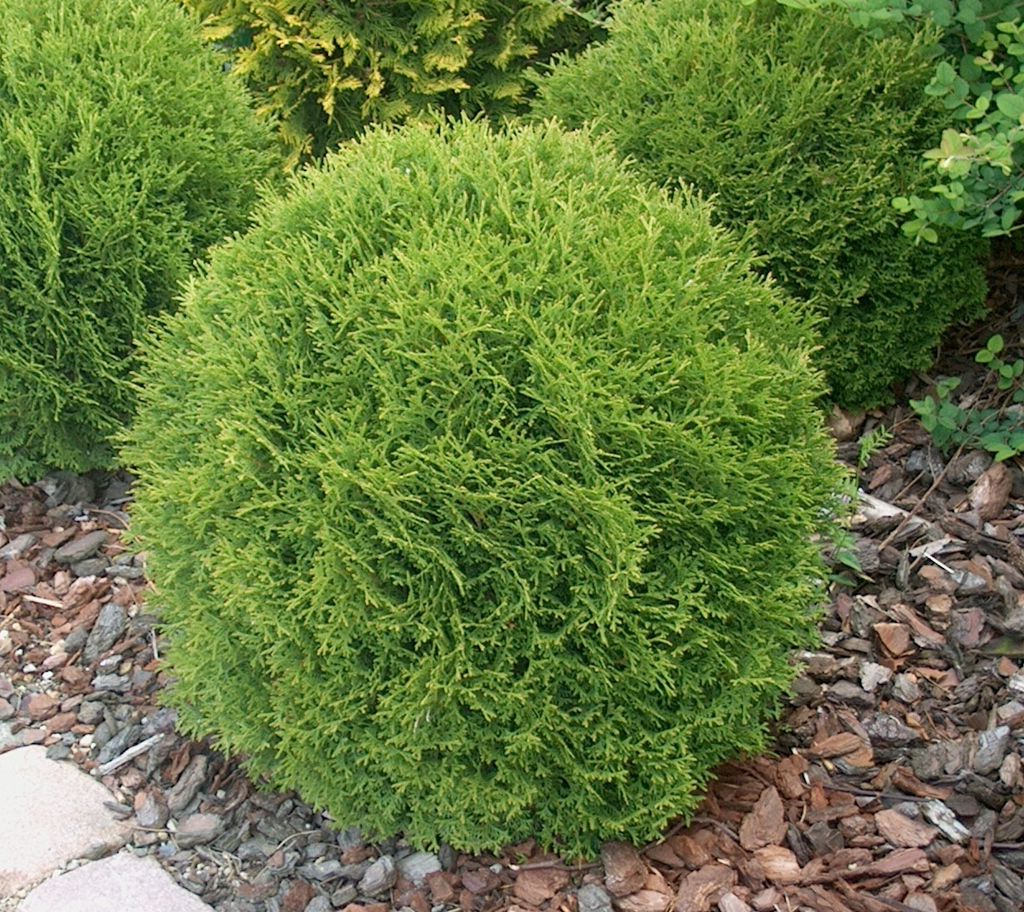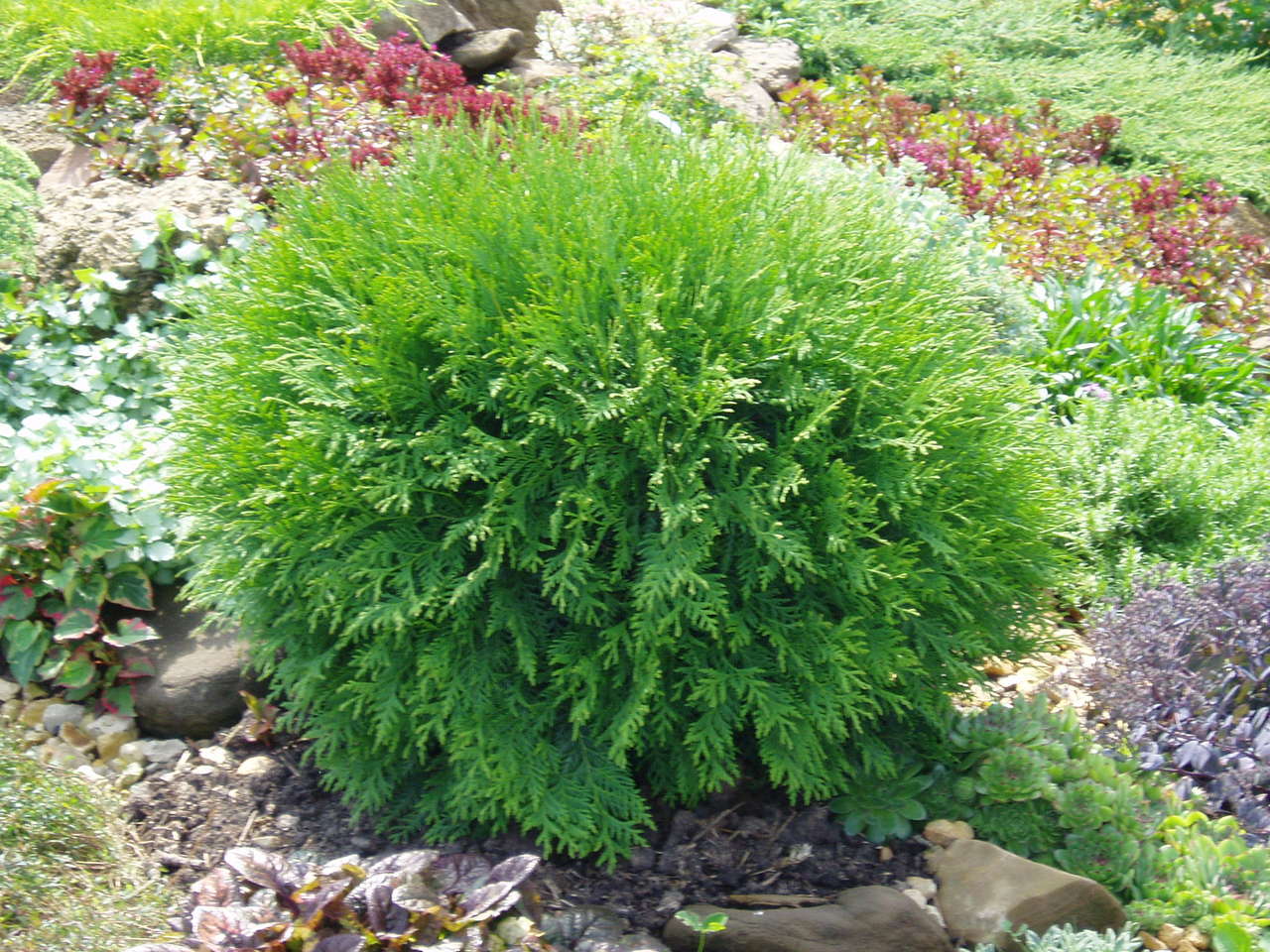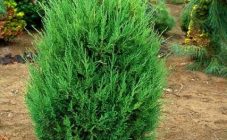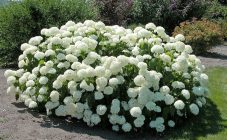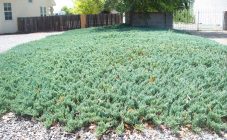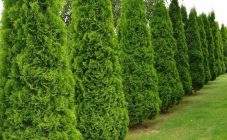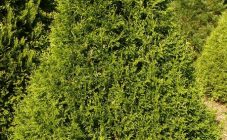Content:
Evergreens give the landscape a lively and vibrant look. One of the possible options for this design may be spherical thuja. This article will tell you about this plant and its varieties.
This beautiful evergreen is native to eastern North America. Caring for him does not require much additional effort.
Description of varieties
There are several widespread species of this plant. Here are some globular thuja varieties.
Danica
The Danica variety is one of the smallest varieties of this plant. This is a dwarf thuja. The height of the bush in this case is no more than 50 cm. Throughout the year, the plant has green scaly foliage. This variety has a dense crown when grown. The bark of the thuja is brown, it can have a reddish or gray tint.
The root system is shallow, in summer it mainly spreads in breadth. This variety is usually used in small areas.
Golden Globe
This stunted species was named in this way due to the special color of the leaves. Its foliage in the autumn has a special color - green with a beautiful copper tint. In spring, the yellow spherical leaves of the thuja have a golden color. This kind of spherical thuja grows rather slowly, it does not tolerate dry air, but likes to be in the shade. This variety is usually used to decorate terraces or loggias.
Globoza
Shoots grow vertically, in an adult plant they are directed upwards. The crown has a rounded crown. This columnar variety can tolerate dry periods normally. Its leaf color changes, depending on the season. In this case, the color can vary from light green to brownish.
Tuya Tini Tim
This variety of thuja ball has leaves of a characteristic shape: they are flat and feather-like. The growth of this variety is slow. It is important for him to have constant lighting. Tiny Tim grows well in almost any soil. The ball thuja variety is highly frost-resistant. It finds its application in design in group seating or in slides.
Teddy variety
It was recently bred. This is one of the spherical thuja varieties. The crown is similar in shape to a pillow. This is due to the fact that it is thick and dense, while the branches fit tightly to each other. The growth rate of such a variety of thuja is low - it does not exceed three centimeters per year.
This variety is capricious when it comes to finding the right soil. In addition, it can hardly tolerate dry air. The plant requires constant replenishment of the soil with useful substances.
Woodwardy
This pyramidal variety has minimum requirements for planting in the soil and for plant care. The crown shape can be ovoid. This variety grows small cones. Grows well in partial shade.
Miriam
This species has a characteristic external shape. This plant has a symmetrical crown. This is a round thuja. In spring, the colors of the leaves become bright, in winter they acquire a brown color. Prefers well-moisturized soil and good sunlight. Used to create Japanese-style designs.
Agrotechnology for growing thuja globular
If thuja is grown, a spherical planting and care in the garden are carried out as follows.
It is recommended to purchase plant seedlings and plant them in the soil in early spring.
In order for the thuja to grow well, you need to carefully consider the choice of a place for planting it. Each variety has its own characteristics, and the choice of a landing site should be based on them.
The best conditions to care for thuja will be in those places that are in the shade and protected from direct sunlight.
When digging a hole for a seedling, you need to wait with planting at least a day in order to allow the soil in it to be saturated with oxygen. It is desirable to do this, but if necessary, you can plant thuja immediately.
The depth of the hole prepared for the seedling depends on the size of the pot in which it is located. It is important to make the indentation so that the neck of the plant is flush with the soil. The stem of the plant must be above the ground. Its width should be greater than that of the pot. This is due to the fact that subsequently the roots of the plant will intensively grow in breadth.
It should be borne in mind that there are such varieties of thuja globular, which require intensive feeding of the soil with useful substances.
The transplant takes place as follows. First, the plant seedling in the pot needs to be watered well. This is done in order to facilitate the process of removing the plant's root system from the pot. Taking out the juice from the pot, they place it in the pit. After that, carefully gradually begin to cover the roots of the plant with earth. After completing this process, you need to lightly press down the newly poured soil.
A small hole should be made next to the plant. It is needed for watering. A newly planted seedling must be watered abundantly. In this case, water should fall into a previously prepared hole. This is necessary so that it does not spread away from the plant.
The thuja tree just planted in open ground has not yet taken root in a new place. It is necessary to ensure regular watering for him. To do this, it must be done weekly. Each plant will need at least one bucket of water each time you water it.
When the hot period comes, the plant's need for watering increases. It can be done at this time twice as often, while increasing the volume of water that is spent on each plant.
If you mulch the land around the plants with peat, this will significantly reduce water evaporation. For this purpose, it is recommended that the peat layer reaches seven centimeters. Such a layer is not only able to solve the problem of excessive evaporation of water, but also to prevent the growth of weeds, and also to supply the soil with useful substances necessary for thuja.
Although the plant can tolerate frost relatively well, some care is nevertheless necessary in such cases. If the frost is not strong, then it is enough to wrap the plant in burlap for this time. This will protect the thuja not only from low temperatures, but also from the piercing cold wind.
This is especially important for young plants. The older ones are easier to tolerate cold winter weather. For them, such care is not necessary.
In the spring, it is necessary not only to remove the burlap, but also to prune the dried branches.
When this plant is grown, it is customary to take care not only of its health, but also of its beautiful appearance. To do this, the crown is regularly trimmed, forming the desired design of the garden or park.
An important issue when leaving is to ensure the density of the crown. To keep it from thinning, you need to abundantly supply the soil with fertilizers and nutrients. You also need to remember about regular watering. Lack of moisture can be one of the reasons that the crown is thinning out.
Advantages and disadvantages of the variety
Thuja globular is a beautiful evergreen that is widely used in landscape design. Its advantages include:
- It is resistant to excessive moisture.
- Withstands cold weather and frost well.
- Doesn't require any special care during the growing process.
- A beautiful plant that has found wide application in landscape design.
The disadvantage is that some varieties are sensitive to the choice of suitable soil and the quality of plant nutrition.
Thuja evergreen is capable of pleasing the eye throughout the year. This requires only minimal maintenance. Choosing this plant for a yard, garden or park will give it a special and unique look.
